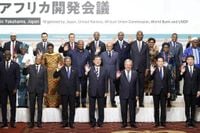The Ninth Tokyo International Conference on African Development (TICAD 9) concluded this week in Yokohama, Japan, marking a notable shift in the approach to fostering African economic growth and partnership. Unlike previous years, when the summit was often defined by headline-grabbing government aid pledges, this edition pivoted toward catalyzing private sector investment and regional connectivity, setting the stage for a new era in Japan-Africa relations.
For those tracking the evolution of international development, the change in tone was unmistakable. In the past, Japanese officials would announce sizeable aid packages—like the $30 billion commitment made at the previous TICAD. This year, however, such government-to-government largesse was conspicuously absent. Instead, as Haoliang Xu, acting administrator of the UN Development Programme, told African Business, “There’s a decline of ODA (official development assistance),” referencing the abolition of USAID and reductions in European aid budgets. “In any case, ODA is not going to be the solution. So, I think we have to really work together to create solutions.”
This sentiment was echoed throughout the summit, where the focus was firmly on harnessing the power of the private sector. Xu noted that discussions this year were “more serious than in the past” about catalyzing Japanese private sector investment in Africa. The challenge, he said, remains overcoming the traditional risk aversion of Japanese investors—a hurdle that will require creative solutions and robust partnership frameworks.
One of the most significant outcomes of the summit was the announcement of a plan to provide $5.5 billion in loans through the African Development Bank (AfDB) to support priorities such as infrastructure development. This financial package was formalized on August 21, 2025, when the government of Japan and the AfDB signed a Memorandum of Understanding launching the sixth phase of the Enhanced Private Sector Assistance (EPSA6) agreement. The deal, signed by Japan International Cooperation Agency (JICA) President Dr. Akihiko Tanaka and AfDB Vice President for Power, Energy, Climate and Green Growth Kevin Kariuki, and witnessed by Japan’s Finance Minister Katsunobu Kato, will support regional member countries from 2026 to 2028. Notably, the $5.5 billion figure represents a $0.5 billion increase over the previous phase, EPSA5, with a clear emphasis on ensuring debt sustainability for African nations.
For those who have followed the TICAD process over the years, this shift toward blended finance and private sector engagement marks a maturation of the partnership. Ankit Khandelwal, Mitsubishi UFJ Financial Group’s (MUFG) head of Africa for sovereigns, development finance institutions, and blended finance, told African Business that the “two key themes” of TICAD 9 were “to support private sector, to drive growth; and to support regional connectivity, to support trade.” According to Khandelwal, “I think this is the first conference, certainly the first TICAD conference, where there was not a single meeting or important panel where the words ‘blended finance’ were not used. It’s clearly a big, big focus, and reflects the realities and availability of concessional financing.”
Japanese financial institutions, some of the world’s largest, played a prominent role at the summit. MUFG signed three Memoranda of Understanding (MoUs) with the African Trade & Investment Development Insurance, Africa Finance Corporation, and Turkish energy company Çalık Enerji. These agreements are expected to unlock new avenues for investment and collaboration across key sectors, including energy and trade insurance—areas critical for Africa’s long-term economic resilience.
Prime Minister Shigeru Ishiba, standing alongside African leaders, underscored Japan’s commitment to fostering trade and investment across what he described as the “Indian Ocean-Africa” region. To this end, Ishiba launched the “Economic Region Initiative,” which aims to deepen economic ties and facilitate greater movement of goods, services, and capital between Africa and Asia. As part of this broader vision, Ishiba also announced a new partnership with Mozambique, Malawi, and Zambia to develop the Nacala Corridor—a vital trade route for mineral and commodity exports from Africa to Japan and the rest of Asia.
The Nacala Corridor project is emblematic of the summit’s focus on regional connectivity and infrastructure as the backbone of sustainable development. By improving logistics and transport links, the initiative is expected to boost trade flows, create jobs, and enhance the competitiveness of African exports in global markets. For countries like Mozambique, Malawi, and Zambia, which are rich in natural resources but often face logistical bottlenecks, the corridor could be a game-changer.
Yet, despite the optimism, there was a clear-eyed recognition of the challenges ahead. As Xu pointed out, Japanese investors have traditionally been risk-averse when it comes to Africa, often citing concerns about political stability, regulatory uncertainty, and infrastructure deficits. Khandelwal, too, acknowledged these hurdles but struck an optimistic note: “The money is definitely there, the requirement is definitely there. Ultimately, the challenge is to help de-risk investments to allow much greater volumes of capital to flow into Africa.”
Blended finance—the strategic use of development finance to mobilize additional private sector investment—was the buzzword of TICAD 9. The approach, which leverages concessional funds to mitigate risks and attract commercial capital, has gained traction as traditional sources of aid dwindle. For African nations seeking to finance ambitious infrastructure and industrialization agendas, blended finance offers a promising pathway.
The EPSA6 agreement, with its $5.5 billion financial package, stands as a concrete example of this new direction. By working together, JICA and the AfDB aim to mobilize resources while keeping a close watch on debt sustainability—a key concern as African countries seek to avoid the pitfalls of unsustainable borrowing seen in previous decades.
For Japanese stakeholders, the summit was also an opportunity to showcase the country’s commitment to Africa’s development, even as the nature of that commitment evolves. The emphasis on private sector solutions, regional partnerships, and innovative financing mechanisms reflects both the changing realities of global development and the growing sophistication of Africa’s economic landscape.
As TICAD 9 fades from the headlines, the real test will be in the follow-through. Will Japanese investors overcome their traditional caution and seize the opportunities on offer? Will African governments and institutions be able to create the enabling environments needed for private sector-led growth? And will the ambitious infrastructure projects announced at the summit translate into tangible improvements for ordinary Africans?
One thing is clear: the partnership between Japan and Africa is entering a new phase—one defined less by aid and more by investment, innovation, and shared prosperity. The decisions made in Yokohama this week could shape the continent’s economic trajectory for years to come.





